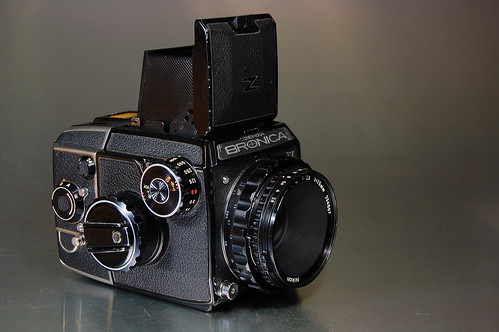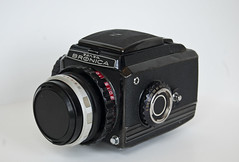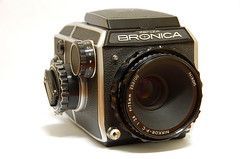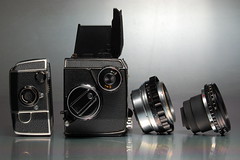Bronica 6×6 focal plane
Evolution
The first Bronica cameras were a series a 6×6 focal plane shutter SLRs, similar in concept to the Hasselblad 1000 F.
| ||
|
Bronica Z / D
The first model early on is often just called Bronica upon introduction. It was also called Bronica Z because of the big Z on the hood. It was produced in 1958.
The Bronica D or Bronica Deluxe is a very similar camera to the Z. The name was introduced in approx 1960.
Bronica S
The Bronica S introduced in 1961, has new incompatible finders and backs. It was originally designed as a simplified model of the deluxe. It's major improvement was a redesign of the gearing film advance system that has caused problems with the previous model. There were many features no longer on the Bronica S that were available on the previous models.
Bronica C
The Bronica C is the corresponding budget version of the S and S2, without the interchangeable back. It was released before the S2, but shares many of the same designs and functions. The model C was quickly replaced with a nearly identical revision known as Bronica C2. It was released a year later, a few months before the S2. The C2 revision is often just called Bronica C as many markets did not have the original C. The improvements made to the body were incorporated into a revised C model along with 1/1000 shutter speed and 220 film compatibility.
Bronica S2
The Bronica S2, released in 1965, is the successor of the Bronica S. The new model included a number of minor changes, but the main improvement was the switch to a removable helical focusing mount.
The Bronica S2A was released in 1969 and is the successor of the S2. Feature wise it was identical to the S2.
Bronica EC
The Bronica EC was released in 1972. It has an electronically controlled shutter, and the Bronica EC-TL adds a TTL exposure meter. A newer revision called EC-TL II was also produced that changed the slow shutter speeds, because of that different finder screens are required.
|
|
Bronica 6x6 specification matrix
| Z / D | S | C | C2 | S2 / S2A | EC | |
|---|---|---|---|---|---|---|
| Introduction | 1959 | 1961 | 1964 | 1965 | 1964 / 1965 | 1972 |
| Type | 2 1/4 x 2 1/4 (6cm × 6cm) Single lens reflex camera | |||||
| Lens mount | Small bayonet Large bayonet 57mm screw mount 1mm pitch | |||||
| Film back | removable | integrated w/ film magazines | removable | |||
| Film | 120 roll film 12 exposures |
120/220 roll film 12/24 exposures | ||||
| Finder | Fresnel lens and large magnifier | also interchangeable with TTL exposure meter. | ||||
| Viewfinder hood | interchangeable with pentaprism finder or magnifying hood | also interchangeable with screens and magnifiers | ||||
| Focusing | built-in non-removable Helicoid type | Removable, Helicoid type, stroke 14mm, rotating angle of focusing ring 250° | ||||
| Distance Scale1) | 50mm / 135mm | 75mm, 50mm, 135mm lenses | 75mm, 50mm, 135mm, and 200mm lenses | 75 and 100mm lenses | ||
| Mirror | flip down, instant return, automatic mirror system | with two piece split flipping up and down | ||||
| Mirror lock | Yes | No | Yes | |||
| Diaphragm | Auto for majority of normal lenses, preset mainly for telephoto. | |||||
| Depth-of-Field | Depth-of-field can be checked by pressing preview button | |||||
| Shutter | Vertical-travel focal plane shutter | with electronic control | ||||
| Shutter Speeds | B, 1, 1/2, 1/4, 1/8, 1/15, 1/30, 1/60, 1/125, 1/250, 1/500 | |||||
| 1/1250 | 1/1000 | 1/500 | 1/10002) | 1/1000 | ||
| 2 to 10 sec | N / A | 2 and 4 sec | ||||
| Flash sync | F: B to 1/15 M: B to 1/250 FP: All speeds X: B to 1/15; 1/50 |
F: B to 1/15 M: B to 1/125 FP: All speeds X: B to 1/15; 1/40 |
M: B, 4s to 1/15 F: B, 4s to 1/30 FP: B, 4 to 1/15; 1/125 to 1/1000 X: B, 4s to 1/60 | |||
| Multiple exposure | Yes | N / A | Yes | |||
| Self timer | Yes, adjustable delay 1 to 10s | N / A | ||||
| Film winding | winding crank or knob | |||||
| Power | N / A | 1x PX28 | ||||
| Dimensions | 89 × 86 × 136mm | 100mm × 100mm × 140mm | 139 × 117 × 170mm | |||
| Weight | 1.165 kg | 1.790 kg | 1.780 kg | 1,980 kg | ||
- since many models have removable focus helicoids, scales may differ.
- some only have 1/500 speed labelled on knob, but support 1/1000
Bibliography
- Asahi Camera (アサヒカメラ) editorial staff. Shōwa 10–40nen kōkoku ni miru kokusan kamera no rekishi (昭和10–40年広告にみる国産カメラの歴史, Japanese camera history as seen in advertisements, 1935–1965). Tokyo: Asahi Shinbunsha, 1994. ISBN 4-02-330312-7. Items 1513–7. (See also the picture on p.22.)
- Lewis, Gordon, ed. The History of the Japanese Camera. Rochester, N.Y.: George Eastman House, International Museum of Photography & Film, 1991. ISBN 0-935398-17-1 (paper), 0-935398-16-3 (hard). Pp.102–3, 138 and 147.
- McKeown, James M. and Joan C. McKeown's Price Guide to Antique and Classic Cameras, 12th Edition, 2005-2006. USA, Centennial Photo Service, 2004. ISBN 0-931838-40-1 (hardcover). ISBN 0-931838-41-X (softcover). Pp.159–62.
- Sugiyama, Kōichi (杉山浩一); Naoi, Hiroaki (直井浩明); Bullock, John R. The Collector's Guide to Japanese Cameras. 国産カメラ図鑑 (Kokusan kamera zukan). Tokyo: Asahi Sonorama, 1985. ISBN 4-257-03187-5. Items 2071–4.
Links
General links
In English:
- Bronica Users Group (BUG) at the Yahoo Groups site
- Bronica pages, including links to manuals for several models, formerly at Robert Monaghan's Medium Format Photography website (medfmt.8x.com: archived copy at the Internet Archive, 8 May 2006).
- Bronica D, Bronica S, Bronica EC and Bronica EC-TL at Cameraquest
- Bronica focal-plane cameras at Nikkor lenses for medium format cameras by Hiura Shinsaku
- Bronica S2 at Cosmonet's Classic Camera website (archived)
- Bronica Identification and Features at www.craigcamera.com
In French:
In Japanese:
- Bronica focal-plane cameras and lenses at Hiura Shinsaku's camera site
- Bronica Deluxe at Hayata Camera Laboratory
- Bronica S and Bronica EC at Asacame
Sample pictures
- Pictures with Bronica S2a by luis triguez




